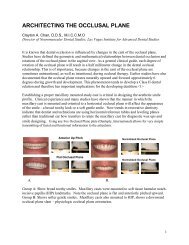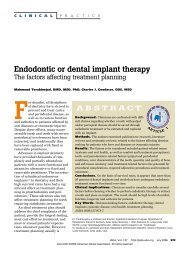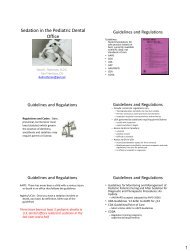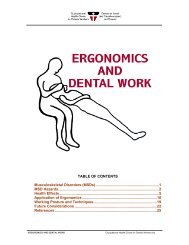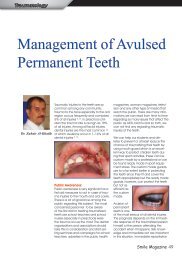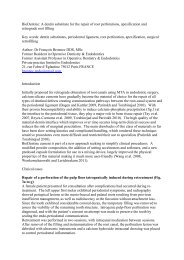apd_mgz_p1-1-4
apd_mgz_p1-1-4
apd_mgz_p1-1-4
You also want an ePaper? Increase the reach of your titles
YUMPU automatically turns print PDFs into web optimized ePapers that Google loves.
Case Report<br />
of posterior occlusion and avoidance of<br />
anterior hyperfunction are considered the<br />
primar y treatment suggestions for this<br />
complex condition. Saunder et al (1979) 3<br />
and Jameson (2001) 4 suggested the use of an<br />
alternative tooth form and occlusal concept<br />
(linear occlusion) and minimum anterior<br />
contact for reducing further bone loss caused<br />
by hyperfunction of anterior teeth. Previous<br />
studies advocated osseointegrated implantretained<br />
or implant-supported prostheses to<br />
change the occlusal force distribution and<br />
decrease the traumatic stress to the alveolar<br />
bone resulting from combination syndrome. 5<br />
T h e p r e s e n t r e p o r t d e t a i l s t h e<br />
prosthodontic management of a specific<br />
patient exhibiting symptoms of combination<br />
syndrome.<br />
Case Report<br />
A 73-year-old male patient was referred to<br />
the Dentistry Department of Taipei Medical<br />
University Hospital in Taipei, Taiwan, for<br />
restorative treatment. The patient's chief<br />
complaints were inadequate retention of<br />
maxillary complete denture and inability<br />
to chew comfortably. No major systemic<br />
diseases or drug allergies were reported. On<br />
examination, the patient had an edentulous<br />
maxilla and nine natural mandibular anterior<br />
teeth (Figure 1). Clinically, the patient<br />
displayed anterior bone loss and flabby<br />
tissue of the maxillary ridge, overgrowth of<br />
the maxillary tuberosities, and over-erupted<br />
mandibular anterior teeth (Figure 2). The<br />
patient rejected any surgery and implant<br />
therapy due to financial considerations. The<br />
patient agreed to have a new complete denture<br />
and a mandibular removable partial denture<br />
Figure 1. Panoramic radiograph showing<br />
a typical case of combination syndrome<br />
with severe resorption of the anterior<br />
maxillary and super-eruption of unopposed<br />
mandibular anterior teeth.<br />
(a)<br />
(b)<br />
(c)<br />
(d)<br />
(e)<br />
Figure 2.: (a) Occlusal view of maxillary<br />
arch. (b) Occlusal view of mandibular<br />
arch showing tooth crowding. (c)<br />
Right-side view revealing the retained<br />
canine. (d) Preoperative frontal view<br />
showing greater bone resorption of the<br />
premaxillary area. (e) Left-side view<br />
indicating sufficient restoration space.<br />
Journal of Prosthodontics and Implantology 23



